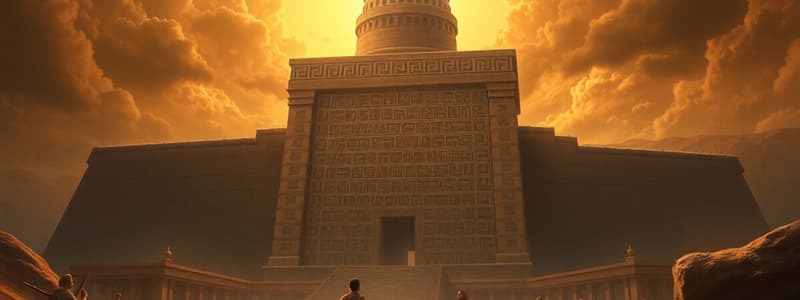Podcast
Questions and Answers
What was the primary purpose of Hammurabi's Code?
What was the primary purpose of Hammurabi's Code?
- To establish a religious hierarchy
- To promote trade among city-states
- To hold people accountable for their actions (correct)
- To create a system of divine laws
The Sumerians were the first civilization to develop a writing system called cuneiform.
The Sumerians were the first civilization to develop a writing system called cuneiform.
True (A)
What river is referred to as the 'Gift of the Nile'?
What river is referred to as the 'Gift of the Nile'?
Nile River
King Narmer is known for uniting ______ and ______ Egypt.
King Narmer is known for uniting ______ and ______ Egypt.
Which of the following inventions is attributed to the Sumerians?
Which of the following inventions is attributed to the Sumerians?
Match the following Sumerian cities with their description:
Match the following Sumerian cities with their description:
Pharaohs were believed to control events such as the flooding of the Nile.
Pharaohs were believed to control events such as the flooding of the Nile.
What was the significance of mummification in ancient Egypt?
What was the significance of mummification in ancient Egypt?
Study Notes
Babylonian Empire - Hammurabi's Code
- Hammurabi's Code was a set of laws created in ancient Babylon, designed to hold people accountable for their actions.
- The laws were inscribed on stone and displayed throughout the empire for everyone to see.
Fertile Crescent & Mesopotamia
- The Tigris and Euphrates rivers flowed from Turkey to the Persian Gulf, creating fertile land that supported agriculture for over 6,000 years.
- Mesopotamia, meaning "land between the rivers," was known as the "Fertile Crescent" for its rich and productive land.
Sumerians
- People began farming in southern Mesopotamia by 4500 B.C., with the Sumerians arriving around 3300 B.C.
- Sumerians faced challenges such as irrigation, defense, and trade, to which they developed solutions:
- Irrigation: They dug canals to bring water to crops.
- Defense: They built mud-brick walls around their cities.
- Trade: They exchanged goods for materials like wood and metal.
- By 3000 B.C., Sumerians established independent city-states, like Uruk and Ur, which functioned as small countries.
- Sumerians worshipped multiple gods (polytheistic), with Enlil being the god of storms.
- Sumerian society had a distinct social hierarchy with kings, priests, and merchants at the top, while most people were farmers.
- They developed innovations like the wheel, sail, plow, and a writing system called cuneiform.
Egyptian Civilization
- The Nile River, flowing northward for 4,100 miles, provided fertile land for ancient Egyptian settlements.
- The Nile's annual floods deposited rich soil, a crucial resource for Egyptian agriculture and their reverence.
- Upper Egypt, located in the south, was situated on higher ground.
- Lower Egypt, in the north, comprised the Nile Delta as the river met the Mediterranean Sea.
- King Narmer unified Upper and Lower Egypt around 3000 B.C., a historical event documented on the Narmer Palette.
- Pharaohs ruled as god-kings, wielding authority over both government and religion, and were believed to control events such as the Nile floods.
- Pharaohs were believed to have an "eternal life force" (ka) and were buried in pyramids alongside items for the afterlife.
- Egyptian elites were mummified to preserve their bodies for the afterlife, with tombs often containing clothing, food, and scrolls to aid them in the afterlife.
Studying That Suits You
Use AI to generate personalized quizzes and flashcards to suit your learning preferences.
Related Documents
Description
This quiz explores the key aspects of ancient Babylon, including Hammurabi's Code and the significance of the Fertile Crescent. It also covers the Sumerians' farming practices and their innovative solutions for irrigation, defense, and trade. Test your knowledge of this fascinating historical period!




